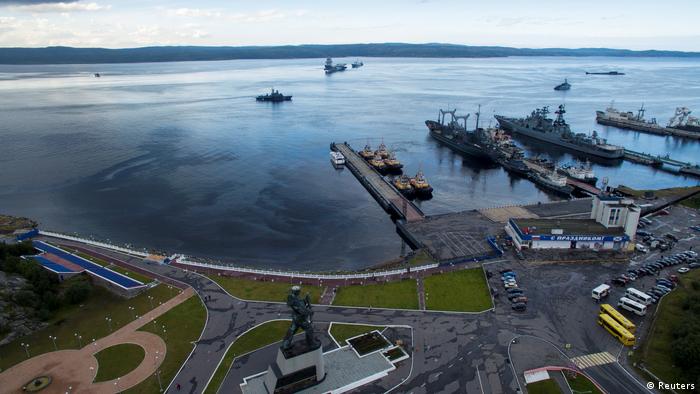Since the fire, on a deep-sea station of the Russian Navy, in which 14 people were killed, has passed a month. Slowly, Details leakage, but so far, many questions remain open. An Overview.

Four of the ten sailors, including senior officers, were killed on 1. July in a fire on a deep sea station on a secret Mission in the Barents sea. The Public learned about it a day later. Since then, the victims in St. Petersburg were buried, in the press there were new Details, and President Vladimir Putin met with the families of the bereaved. However, there are still more questions than answers.
What happened in the Barents sea?
Since the first Declaration of the Russian defense Minister, Sergei Shoigu, there are hardly any new insights. All the information about the U-boat and its Mission is classified as a state secret. “In the context of the Work planned for the exploration of the seabed in Russian waters of the Barents sea, a fire broke out on Board a research deep-sea apparatus of the Northern fleet”, – said Shoigu at the Meeting with Putin at the 2. July. “14 sailors came by smoke inhalation killed”. Four crew members and a civilian expert were saved.
Later, Shoigu said that the fire had broken out in the battery Department, and that the deep sea station has a nuclear drive. The reactor was not affected, the Station had been dragged to the base in Severomorsk and will be repaired.

Defense Minister Shoigu to inform Russia’s President Putin about the fire on the submarine (2. July)
The so far most detailed report in the Moscow newspaper “Kommersant” at the end of July, published. After that, the accident occurred on the deep-sea station AS-31, in the case of the modified Atom-U-Boot “Podmoskowje” is used as a carrier. The crew was in the process of checking before a bet. When Docking to the carrier-U-boat had come in the battery Department smoke out. A part of the crew was saved on the carrier-U-boat, while ten officers tried for more than an hour to fight the fire. You, but also four members of the replacement crew were killed, probably by the Explosion of the battery. “Kommersant” writes that the battery was installed after 2014, and the Russian production came; before that a Ukrainian battery was used.
What do we know about the deep sea station
Official information on the deep-sea station, there is not. In the press, the speech reports in the times of AS-31, times of AS-12. Some call them “Losharik” after a Soviet cartoon about a balls composite horse. The background for the nickname of a special feature of the construction is: The deep sea station consists of several spherical components made of pressure-resistant Material cover, which looks like a conventional U-boat. It is said that the Station can dive up to 6000 meters deep. This indicates that it was designed for operations in the Atlantic or Pacific ocean, where there is such Deep. So far, there are only a few civilian submersibles, which can dive as deep. Military U-used boats in Depths from a few hundred up to a maximum of 1000 meters.
Michael Kofman, an expert of the Washington-based think tank Center for Naval Analyses (CNA), writes in his Blog that AS-31 “Losharik” was around 70 meters long. The Station was built in the 1990s and early 2000s in service.
Russian U-boats in the vicinity of TRANS-Atlantic cable
To build U-boats for great Depths is a “very complex operation”, says Andreas Burmester, member of the Executive Board of ThyssenKrupp Marine Systems, the U-boats for the German Navy is building. “In General, trying to in this Deep (up to 6,000 meters – approx. d. Red.) not to bring people; to only certain research purposes made it,” says Burmester in an interview with DW. “In addition to the charges for the outboard valves, the design of the pressure body great challenges, because, among other things, high-strength special materials must be used, which can be not easy to process. Furthermore, the pressure body is very heavy, so quickly, a weight and volume problem in the design arises.” His conclusion: “in The end, it is very, very expensive.”

A base of the Russian Northern fleet in the port of Severomorsk in Northern Russia
For the U.S. Navy, the Russian deep-sea stations are no secret. The Washington Post quoted in December 2017, the commander of NATO’s submarine force, rear Admiral Andrew Lennon, according to the Alliance about Russian deep-sea stations know know, which are carried by converted nuclear submarines. Such stations are able to operate deep-sea research, but also education and information, Lennon. You think that you can be equipped to manipulate “objects on the seabed”. Lennon mentioned in this connection that a Russian submarine had been spotted boats more and more often in the vicinity of the communication cable in the North Atlantic.
Stephen Blank of the US think-tank American Foreign Policy Council, said in a DW interview, U-boats were the “crown jewels” of the Russian Navy. They were better than their predecessors from the Soviet era, especially thanks to new IT technologies and new electronics. Deep-sea stations, such as “Losharik” could be used “to places for nuclear-U looking for boats to where they are and the inserts can move out,” says Blank. Such stations could also hear in the North Atlantic TRANS-Atlantic cable, or in case of damage. The NATO was informed of this and have revived a command center from the time of the Cold war. In addition, the NATO have strengthened as a response to Russia’s activities in the Atlantic, your U-boat defence.